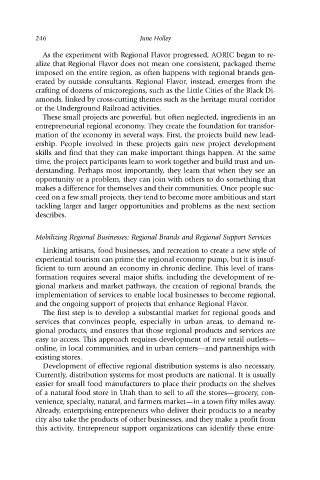Page 257 - 1-Entrepreneurship and Local Economic Development by Norman Walzer (z-lib.org)
P. 257
246 June Holley
As the experiment with Regional Flavor progressed, AORIC began to re-
alize that Regional Flavor does not mean one consistent, packaged theme
imposed on the entire region, as often happens with regional brands gen-
erated by outside consultants. Regional Flavor, instead, emerges from the
crafting of dozens of microregions, such as the Little Cities of the Black Di-
amonds, linked by cross-cutting themes such as the heritage mural corridor
or the Underground Railroad activities.
These small projects are powerful, but often neglected, ingredients in an
entrepreneurial regional economy. They create the foundation for transfor-
mation of the economy in several ways. First, the projects build new lead-
ership. People involved in these projects gain new project development
skills and find that they can make important things happen. At the same
time, the project participants learn to work together and build trust and un-
derstanding. Perhaps most importantly, they learn that when they see an
opportunity or a problem, they can join with others to do something that
makes a difference for themselves and their communities. Once people suc-
ceed on a few small projects, they tend to become more ambitious and start
tackling larger and larger opportunities and problems as the next section
describes.
Mobilizing Regional Businesses: Regional Brands and Regional Support Services
Linking artisans, food businesses, and recreation to create a new style of
experiential tourism can prime the regional economy pump, but it is insuf-
ficient to turn around an economy in chronic decline. This level of trans-
formation requires several major shifts, including the development of re-
gional markets and market pathways, the creation of regional brands, the
implementation of services to enable local businesses to become regional,
and the ongoing support of projects that enhance Regional Flavor.
The first step is to develop a substantial market for regional goods and
services that convinces people, especially in urban areas, to demand re-
gional products, and ensures that those regional products and services are
easy to access. This approach requires development of new retail outlets—
online, in local communities, and in urban centers—and partnerships with
existing stores.
Development of effective regional distribution systems is also necessary.
Currently, distribution systems for most products are national. It is usually
easier for small food manufacturers to place their products on the shelves
of a natural food store in Utah than to sell to all the stores—grocery, con-
venience, specialty, natural, and farmers market—in a town fifty miles away.
Already, enterprising entrepreneurs who deliver their products to a nearby
city also take the products of other businesses, and they make a profit from
this activity. Entrepreneur support organizations can identify these entre-

